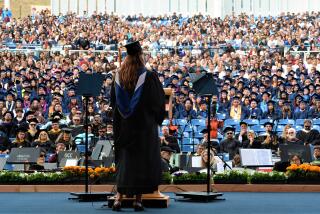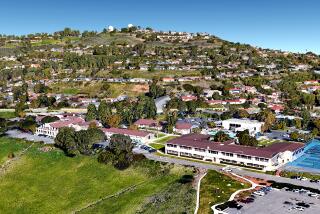Mount Saint Mary’s College becomes Mount Saint Mary’s University
- Share via
Mount Saint Mary’s is a college no more.
More precisely, the Catholic-affiliated school with two campuses in Los Angeles is now a university.
The 3,100-student school changed its name recently to better reflect its substantial graduate-degree programs in addition to its undergraduate enrollments, according to President Ann McElaney-Johnson.
Being called Mount Saint Mary’s University “represents the school in a more accurate way” and lets the world know more of its wider research and service missions, she said.
According to widely followed classifications developed by the Carnegie Commission on Higher Education, schools that award at least 50 master’s or doctoral degrees in a year can be considered universities rather than colleges.
Mount Saint Mary’s has been fulfilling that measurement since 1993 but only recently decided to undertake all the changes of signage, letterhead and websites, along with registering the revised name with state and federal agencies, McElaney-Johnson said. The school for years already was categorized as “a regional university” in the U.S. News & World Report listings.
Founded as a women’s college in 1925 by the Sisters of St. Joseph of Carondelet, Mount Saint Mary’s currently has 2,000 students in its undergraduate programs, most of whom are women.
The school’s Chalon Campus is located just above the Getty Center in the Brentwood hills; its Doheny Campus in the Figueroa corridor, just north of USC, features the historic Doheny Mansion, part of a century-old estate once owned by L.A. oil baron Edward L. Doheny.
Being called a university does not make the school eligible for extra funding or any special formal status, the president said. But more informally, it carries some added prestige and communicates more loudly that Mount St. Mary “is serious in our research and the resources we provide for the community.”
In addition, the use of the word “college” is confusing to some potential students from Asia, Latin America and elsewhere who may think it is a high school, not a campus for higher education, because of the parlance in their countries, officials said.
Twitter: @larrygordonlat
More to Read
Sign up for Essential California
The most important California stories and recommendations in your inbox every morning.
You may occasionally receive promotional content from the Los Angeles Times.














